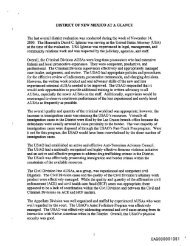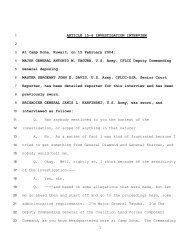The 2003 Index of Hospital Quality
The 2003 Index of Hospital Quality
The 2003 Index of Hospital Quality
Create successful ePaper yourself
Turn your PDF publications into a flip-book with our unique Google optimized e-Paper software.
Phase I<br />
have their own hierarchical method for determining severity <strong>of</strong> illness and will be<br />
discussed later. <strong>The</strong> four severity <strong>of</strong> illness subclasses are:<br />
Subclass (PSC) Severity <strong>of</strong> Illness<br />
1 Minor (Includes non CC)<br />
2 Moderate<br />
3 Major<br />
4 Extreme<br />
<strong>The</strong> severity <strong>of</strong> illness subclass is used in conjunction with the patient’s base APR-<br />
DRG for analysis such as evaluating resource intensity or patient care outcomes.<br />
A patient’s severity <strong>of</strong> illness subclass should not be used with their DRG because<br />
several DRGs may form one APR-DRG. <strong>The</strong>refore, since severity <strong>of</strong> illness<br />
subclasses correspond to the APR-DRG number and not the DRG, it is important<br />
to use the APR-DRG number to accurately interpret data.<br />
<strong>The</strong> process for assigning a patient a severity <strong>of</strong> illness subclass is a three phase<br />
process and is summarized as follows:<br />
C Secondary diagnoses that are closely related to the principal diagnosis are<br />
eliminated from further analysis.<br />
C Remaining secondary diagnoses are assigned one <strong>of</strong> four distinct Standard Severity<br />
<strong>of</strong> Illness Levels. Figure 1 presents examples <strong>of</strong> secondary diagnoses in each<br />
severity <strong>of</strong> illness level.












